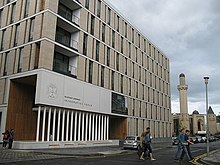Casket letters
[3] Historian Antonia Fraser similarly argues that the documents were whole or partial forgeries, pointing to various inconsistencies in the texts, both with the Queen's known style and with details of geography, date, and relationships with persons mentioned.[4] The Queen's husband, Lord Darnley, was killed in mysterious circumstances at the Kirk o'Field in Edinburgh on 10 February 1567, and she married the Earl of Bothwell on 15 May 1567.At the end of July 1567, the Earl of Moray, who was in London, told Guzman de Silva, Spanish ambassador to England, that he had heard of the finding of a letter in Mary's own handwriting to Bothwell which implicated her in the murder of Lord Darnley.[7] According to the document called "Hay's Book of Articles," compiled by Alexander Hay for the Confederate Lords in November 1568, which narrates events from Darnley's murder to Moray's Regency, the casket and letters were found and made known before Queen Mary agreed to abdicate, and public opinion after their discovery had brought her to that decision.They made and signed a statement in preparation for the Parliament to enact Mary's abdication, which stated the letters demonstrated Mary's involvement in the murder; in so far as by diverse her previe letters writtin and subscrivit with hir awin hand and sent by hir to James erll Boithvile chief executor of the said horrible murthour, ... it is maist certain that sche wes previe, art and part (complicit) and of the actuale devise (plot) and deid of the foir-nemmit murther of her lawful husband the King our sovereign lord's father.Nearly a year later, in October 1568, the Earl of Moray produced the Casket letters and the "Ainslie Tavern Bond" at a conference in York, headed by Thomas Howard, 4th Duke of Norfolk.[10] Moray produced the schedule of accusations known as the "Book of Articles" on 6 November 1568 at Westminster, and showed the casket letters again on 7 December.[12] On 8 December, Moray showed the commissioners seven papers written in French in the "Roman hand" or italic, including a "sonnet" beginning, "O Dieux ayez de moy".Copies and translations were made of these papers, which Moray claimed showed his sister's love for Bothwell and her involvement in Darnley's murder.John Lesley, Mary's secretary, heard from one of her accusers, William Maitland of Lethington, that Elizabeth's purpose was "not to end her cause at this time, but to hold the same in suspense".[19] The contemporary historian, George Buchanan, who was present at York amongst the Scottish commissioners, described Norfolk and Lethington's ride, and their agreement not to reach a decisive conclusion.Under a bed, they found a silver box engraved with an "F" (perhaps for Francis II of France), containing the Casket letters and a number of other documents, including the Mary-Bothwell marriage certificate.[44] Versions of some of the letters and sonnets were printed in George Buchanan's polemic Detectio Mariæ Reginæ and Detectioun, and reprinted by James Anderson in 1727.One of the letters invokes the imagery of the gift of a memento mori ring or locket in the context of Bothwell's absence and Mary's regret.[50] A French version of the letter describes the object as a jewel containing his name and memory joined with a lock of her hair, comme mes chevaulx en la bague.







Mary, Queen of ScotsEarl of BothwellLord DarnleyAdam BlackwoodMary BeatonQueen Elizabeth IJames VI of ScotlandJohn Hungerford PollenAntonia FraserautographKirk o'FieldDarnley's murderEarl of MorayBattle of Carberry HillLochleven CastleabdicatedRegent of ScotlandEdmund GrindalBishop of LondonHenry BullingerGenevaBook of ArticlesAlexander HayParliamentElizabeth I of EnglandDuke of NorfolkAinslie Tavern BondThomas Howard, 4th Duke of NorfolkWestminsterSeton PalaceBishop of OrkneyCommendator of DunfermlinePatrick Lord LindsayHampton CourtLord KeeperEarl of BedfordLord AdmiralRalph SadlerWalter MildmayKing's ManorJohn LesleyWilliam Maitland of LethingtonCawoodGeorge BuchananTower of LondonBolton CastleNorth AllertonEarl and Countess of MarStirling CastleUniversity of EdinburghInformatics ForumEdinburgh CastleJames Douglas, 4th Earl of MortonFrancis II of FranceFrancis WalsinghamDouglas familyWilliam Douglas of LochlevenAssociationRobert BowesPrior of PluscardenEarl of Gowrieforged1st Marquis of DouglasAnne Hamilton, 3rd Duchess of HamiltonLennoxlove HouseEast LothianNational Museums ScotlandScottish GovernmentNational Heritage Memorial FundArt FundNational Museum of ScotlandWilliam CecilWalter GoodallWilliam RobertsonCotton Collectionmemento moriJohn GuyScottish translationsJane DawsonGuy, JohnJohn HosackBritish MuseumT.F. HendersonThe GuardianBBC NewsThomas Finlayson HendersonMalcolm LaingFraser, AntoniaHaynes, SamuelHenderson, Thomas FinlaysonWikisource1911 Encyclopædia BritannicaHosack, JohnLang, AndrewRobertson, WilliamThomson, George MalcolmQueen of ScotlandQueen consort of FranceJames V of ScotlandMary of GuiseJames VI and ICharles IElizabeth, Electress of the PalatinateMargaret TudorEdward VIMary IElizabeth IHenry Stuart, Lord DarnleyJames Hepburn, 4th Earl of BothwellJames, Duke of RothesayJames Stewart, Commendator of Kelso and MelroseJames Stewart, 1st Earl of MorayJohn Stewart, Commendator of ColdinghamRobert Stewart, 1st Earl of OrkneyJean Campbell, Countess of ArgyllCoronationRoyal EntryFirst weddingSecond weddingMurder of Lord DarnleyExecutionFuneralBurning of EdinburghBattle of CorrichieSiege of InvernessMarian civil war